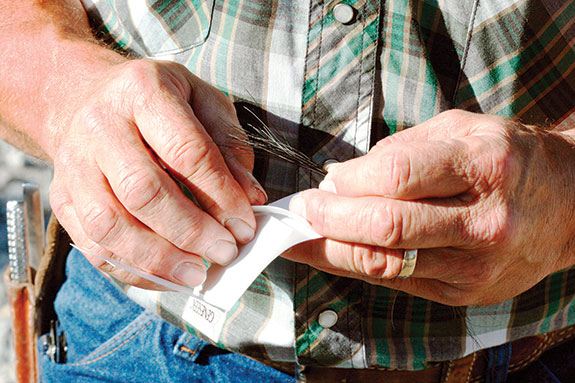“In today’s economy, producers can’t afford to guess when it comes to critical decisions such as which females to keep or bulls to use,” says Dr. Stewart Bauck, general manager of Neogen Agrigenomics.
“The decisions producers make this fall can impact the profitability, and ultimately, the success of their herds for years to come.
Incorporating DNA technology into a ranch management program now allows producers to make better business decisions before potentially costly mistakes are made.”

Nebraska seedstock producer Dick Hollman agrees. He began using DNA technology in his operation almost 15 years ago.
When Hollman got started, he was primarily looking at parentage to assist him in making better breeding decisions.
Today, Hollman uses the information from his DNA results in every aspect of his Angus operation.
Whether making selection decisions for his ranch management program or making marketing decisions for his annual sale, Hollman explains he uses a comprehensive approach.
“I look at the whole picture of the animal – all the way through to the consumer,” says Hollman. “I want to ensure I’m selling an animal that is going to grow and perform well for my customer, be the right size for the feeder and the packer, and tender for the consumer.”
Hollman goes through a mental checklist when making important business decisions for his herd. He first does a visual sort of the animals and then reviews individual animal pedigrees. Next, Hollman reviews the animals’ performance before looking at their EPDs.
“Seedstock producers like Dick Hollman are able to take advantage of breed-specific DNA profiles through beef breed associations,” says Dr. Bauck.
“Utilizing a breed-specific profile provides producers access to genomic-enhanced expected progeny differences (GE-EPDs), resulting in improved accuracies of EPDs. The increase in accuracy is especially important when using young or unproven animals.
“Producers no longer have to wait before seeing a return on their investment; they may now better predict the true genetic potential of their bulls and females earlier and with more confidence to make faster genetic progress,” he says.
The valuable inside information gained through a comprehensive DNA profile, provides seedstock producers with a more marketable product to take to sale and allows commercial producers to make better-informed decisions when making important purchasing decisions, states Dr. Bauck.
Kansas producer John Irvine echoes Bauck’s sentiments. He began using DNA technology in his Simmental and SimAngus herd almost 10 years ago.
“When I started using a genomic profile, I was primarily looking at coat color and polled traits,” Irvine says. “Now I utilize a comprehensive profile through the breed association on all my bull calves and a large portion of my females.”
Like Hollman, Irvine says he first does a visual sort of his animals and then collects samples for DNA testing. “We are committed to providing high-quality, profit-oriented genetics.
We want to make sure we’re providing a complete picture on our sale animals to allow our customers to make the best decisions for their individual operations and herd goals, which is a key to their success, and ours.”
Dr. Bauck notes with the nation’s beef herd at a historic low, commercial cattlemen have an opportunity to take advantage of this economic climate by purchasing bulls and females with a genomic profile.
“As cow-calf producers start planning which sales to attend this fall, they must make sure each bull or replacement female they purchase has been DNA-profiled,” he says.
“That is the easiest and most cost-effective way for any producer to make faster genetic progress, shorten generational intervals and get a leg up on their competition.
“By incorporating DNA technology to the decision-making toolbox now,” he says, “producers can have more confidence that the decisions they are making this fall are setting them up for success for years to come.” ![]()
Dr. Elisa Marques is a market development manager for GeneSeek.
PHOTOS
Nebraska Angus producer Dick Hollman has put DNA profiles to work on his seedstock operation to identify traits that work through the entire lifespan of the offspring calf. Photos by David Cooper.







